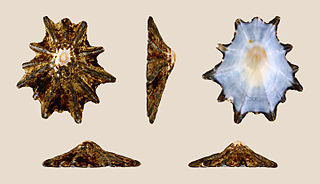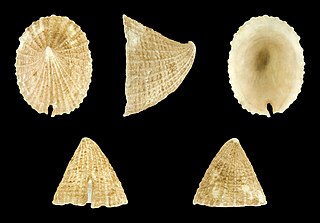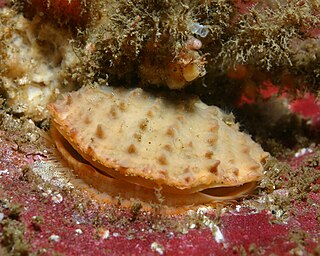
A tide pool or rock pool is a shallow pool of seawater that forms on the rocky intertidal shore. These pools typically range from a few inches to a few feet deep and a few feet across. Many of these pools exist as separate bodies of water only at low tide, as seawater gets trapped when the tide recedes. Tides are caused by the gravitational pull of the sun and moon. A tidal cycle is usually about 25 hours and consists of one or two high tides and two low tides.

The Patellogastropoda, common name true limpets and historically called the Docoglossa, are members of a major phylogenetic group of marine gastropods, treated by experts either as a clade or as a taxonomic order.

Intertidal ecology is the study of intertidal ecosystems, where organisms live between the low and high tide lines. At low tide, the intertidal is exposed whereas at high tide, the intertidal is underwater. Intertidal ecologists therefore study the interactions between intertidal organisms and their environment, as well as between different species of intertidal organisms within a particular intertidal community. The most important environmental and species interactions may vary based on the type of intertidal community being studied, the broadest of classifications being based on substrates—rocky shore and soft bottom communities.

Lottia is a genus of sea snails, specifically true limpets, marine gastropod mollusks in the subfamily Lottiinae of the family Lottiidae, one of the families of true limpets.

A rocky shore is an intertidal area of seacoasts where solid rock predominates. Rocky shores are biologically rich environments, and are a useful "natural laboratory" for studying intertidal ecology and other biological processes. Due to their high accessibility, they have been well studied for a long time and their species are well known.

Lottia pelta, common name the shield limpet, is a species of sea snail, a true limpet, a marine gastropod mollusk in the family Lottiidae. It is still designated under its synonym Collisella pelta in many textbooks.

Cellana sandwicensis, common name the yellow-foot ʻopihi, is a species of edible true limpet, a marine gastropod mollusc in the family Nacellidae, one of the families of true limpets.

Seashore wildlife habitats exist from the Tropics to the Arctic and Antarctic. Seashores and beaches provide varied habitats in different parts of the world, and even within the same beach. Phytoplankton is at the bottom of some food chains, while zooplankton and other organisms eat phytoplankton. Kelp is also autotrophic and at the bottom of many food chains. Coastal areas are stressed through rapid changes, for example due to tides.

Lottia gigantea, common name the owl limpet, is a species of sea snail, a true limpet, a marine gastropod mollusc in the family Lottiidae. Its genome has been sequenced at the Joint Genome Institute.

Lottia digitalis, commonly known as the fingered limpet or ribbed limpet, is a species of sea snail, a true limpet, a marine gastropod mollusk in the family Lottiidae. These limpets are usually found on the surface of rocks in the high intertidal region on the coastal fringes of the north-eastern Pacific Ocean.

Lottia persona is a species of sea snail, a true limpet, a marine gastropod mollusk in the family Lottiidae, one of the families of true limpets.

Patella ferruginea, commonly known as the ferruginous limpet is a species of true limpet, a marine gastropod mollusk in the family Patellidae. It is a large limpet, endemic to the western Mediterranean Sea, and although common in the past, it is now rare and restricted to only a few locations.

Scutellastra longicosta, the long-spined limpet or the duck's foot limpet, is a species of true limpet, a marine gastropod mollusk in the family Patellidae, one of the families of true limpets. It is native to the coasts of South Africa where it is found on the foreshore. It cultivates a species of crustose brown algae in a "garden".

Diodora aspera, also known as the rough keyhole limpet, is a species of sea snail, a marine gastropod mollusk in the family Fissurellidae, the keyhole limpets. Although similar in appearance to a common limpet, it has a hole near the apex of its shell, and is only distantly related. It often has a scaled polychaete worm Arctonoe vittata living inside its shell as a commensal. In the event that it is attacked by a starfish, it extends flaps of mantle to defend itself, and the worm also helps drive the predator away.

Emarginula fissura, the common slit limpet, is a species of sea snail, a marine gastropod mollusk in the family Fissurellidae, the keyhole limpets.

Hemimarginula pumila, the pygmy ermarginula, is a species of sea snail, a marine gastropod mollusk in the family Fissurellidae, the keyhole limpets.

Crassadoma is a genus of rock scallops, marine bivalve molluscs in the family Pectinidae. It is monotypic, the only species being Crassadoma gigantea, the rock scallop, giant rock scallop or purple-hinge rock scallop. Although the small juveniles are free-swimming, they soon become sessile, and are cemented to the substrate. These scallops occur in the eastern Pacific Ocean.

Semibalanus cariosus, commonly known as the thatched barnacle, rock barnacle or horse barnacle, is a species of acorn barnacle occurring in the northern Pacific Ocean.

Lottia instabilis is a species of sea snail, a true limpet, a marine gastropod mollusk in the family Lottiidae. Common names include the unstable limpet, the unstable seaweed limpet and the rocking chair limpet. It is native to the northern Pacific Ocean where it feeds on kelp in the intertidal zone and the shallow sub-littoral zone.

Lottia asmi, commonly known as the black limpet, is a species of sea snail, a marine gastropod mollusk in the family Lottiidae. It is found in shallow water in the eastern Pacific Ocean, usually in the intertidal zone.






















